Two very different Brothers
Edmund Mortimer (d1304)
Roger Mortimer of Chirk (d1326)
Roger Mortimer, the subject of the previous article in this series, had five sons. The heir apparent was Ralph, an impressive young man, displaying all the knightly arts. In 1273 he was sheriff of Shropshire and Staffordshire. From an early age the next son, Edmund, was destined for the church. He was sent to Oxford to study and, at the age of 15, he was appointed as the nominal Treasurer of York by Henry III. Living in the house of the Archbishop of York in Oxford, he had his head down studying theology while his older brother was enjoying himself at tournaments. Promised promotion within the church, Edmund had a glittering career awaiting him. The next son after Edmund was Roger, who was to become a great soldier, destined to play a significant role on the national stage; he is known to us as Roger Mortimer of Chirk.
So, in the evening of his life, Roger Mortimer could feel content that, on his death, the lordship of Wigmore would be safe in Ralph’s capable hands. But everything changed in 1274 when Ralph died. Edmund had his sights set on his career in the church and he had not been groomed or prepared in any way for managing the Mortimer estates or, indeed, fighting the Welsh. His reluctance to accept his new position is obvious from the fact that he remained in Oxford after his brother’s death, rather than immediately moving home to Wigmore. When his father died in 1282, Edmund had no option but to give up the church and take up the reins.
Edmund Mortimer (d1304) was around 30 when his father died and he was Lord of Wigmore for about 22 years. He wasted no time in turning from religion to more violent activities. Less than two months after his father’s death, he hatched a plot with his brothers and some other knights to entrap the Welsh prince Llywelyn ap Gruffudd. Through trickery and astute tactics they separated Llywelyn from his main force which was then defeated. While attempting to rejoin his troops, Llywelyn was stopped by the English forces and run through with a sword. It was only later that the corpse was recognised as Llywelyn’s. So died the great Welshman who had been such a thorn in the flesh of the English, just a few weeks after his Mortimer cousin. Roger of Chirk took Llywelyn’s head to Rhuddlan castle to show King Edward I. His death effectively drew to a close that period of the Welsh struggle against the English.
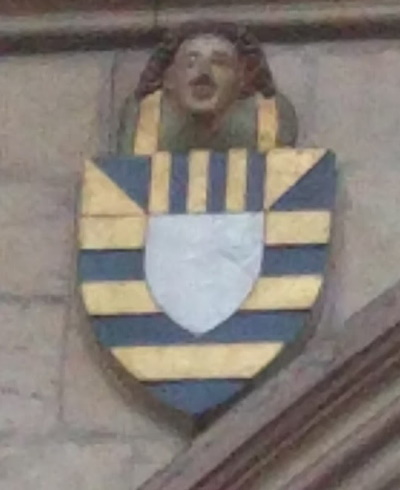
This coat of arms in the chancel in York Minster is dated c.1399. Could it commemorate Edmund’s connection with the church? Is the lack of symmetry at the top a way of differencing his arms as he was a second son?
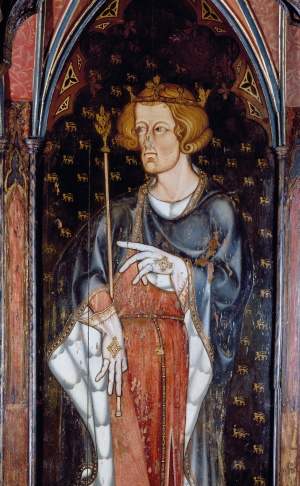
King Edward I
So Edmund became a soldier. Knighted by Edward I in 1283, he was given custody of Oswestry. With the Earl of Hereford he was custodian of Carmarthen and Cardigan castles and he was heavily involved with Roger of Chirk in mobilising troops to suppress the revolt of Rhys ap Maredudd in South Wales in 1287.
But problems were brewing at home. King Edward had to cope with recurring difficulties in Wales and Scotland at the same time as he was forging a military alliance on the Continent against France. He needed to raise a lot of money and, having been granted a tax in 1291, he then departed from tradition and decided to also tax the Welsh. Like other Marcher lords, Edmund had estates in England, in Wales and in the March. Accused of having resisted the collection of the tax in England, he made the now-famous statement that, as the liberty of Wigmore is outside the county, the ‘king’s writ does not run there’. He grudgingly paid the tax on his Welsh lands but secured a royal document guaranteeing that the Welsh tax would not set a precedent.
From 1294 the king’s calls for more and more taxation became crippling and there was growing opposition from the barons to his demand for military service in Gascony. Things came to a head in 1297. Edmund Mortimer supported the earls of Norfolk and Hereford in their resistance to the king and the stage seemed set for a civil war. Surprisingly perhaps, the situation was saved by the defeat of the English at Stirling Bridge in Scotland. The potential threat to the security of England focused the minds of king and barons. Edward approved the Confirmatio cartarum a re-issue of Magna Carta and the Forest Charter and the barons agreed to serve with him in a new Scottish campaign.
It is said that Edmund served with the king in Scotland, though, unlike his brother Roger of Chirk, he is not listed as being present at either the Battle of Falkirk in 1298 or the Siege of Caerlaverock in 1300. He was injured in a skirmish near Builth and died at Wigmore in 1304.
Although never a lord of Wigmore, Roger Mortimer of Chirk (d1326) thoroughly deserves to be included in this catalogue of important Mortimers. The third son of Roger Mortimer, lord of Wigmore, (d1282) he was everything his cerebral, theologically-trained older brother Edmund wasn’t. Knighted in the lifetime of his father, he was a great soldier with a well-earned reputation for severity and intransigence. You would certainly rather have him with you than against you.
As a young man he obviously impressed Edward I. Soon after Roger’s father died, the king wrote to him expressing the hope that he would recover in the son something of what he had lost by the death of the father. He urged him to continue his father’s work by strenuously combating the Welsh uprising.
For his support he was granted lands in the area around Chirk, part of the estates forfeited by the rebellious Welsh, thus creating a new Marcher lordship dominated by the impressive castle he then built at Chirk. As noted above, Roger of Chirk was with his brother near Builth when Llywelyn ap Gruffudd met his end. Also killed on that day was Llywelyn ap Gruffudd ap Madog, the man who had previously owned the lands round Chirk that had been granted to Roger.
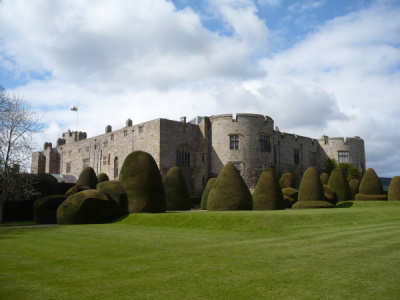
Chirk castle
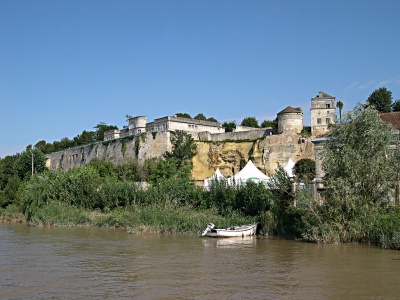
Bourg on the Dordogne estuary
He has been described as a lecher and he certainly had a roving eye. No less a person than the Archbishop of Canterbury accused him of adultery with, among others, Margaret, the wife of Roger of Radnor. When a chaplain attempted to reprove him for his sins, he put him in gaol and this was typical of his high-handed autocratic way of dealing with people.
Roger was heavily involved in suppressing the 1287 revolt of Rhys ap Maredudd in South Wales. In 1294 he took part in Edward I’s expedition to Gascony and was made joint Governor of the riverside towns of Blaye and Bourg after their recapture. It is interesting to note that in 1297, while his brother Edmund, lord of Wigmore, was joining the opposition to the king’s increasingly exacting demands, Roger was again in Gascony, well away from the trouble. The following year he was back home raising troops in Wales to fight against the Scots. He sent 600 Welshmen to fight at the Battle of Falkirk in 1298 and his coat of arms is included on the Falkirk Roll and on that commemorating the siege of Caerlaverock in 1300.
Roger was summoned by the king to a parliament in 1299, thereafter being termed Baron Mortimer of Chirk. Unfortunately his relationship with Edward I ended on a sour note. In 1306 he went with his nephew, Roger Mortimer, the future 1st earl of March, on a new campaign against the Scots. They incurred the king’s wrath by leaving without his permission and both had their lands confiscated for a time.
Things improved for Roger of Chirk following the accession of Edward II. In 1308 he was appointed as Justiciar of both North Wales and South Wales, posts that he held, on and off, until 1322. As the chief representative of the monarch in Wales he became extremely powerful. Active in sorting out problems and putting down rebellion, he made many enemies due to the severity of his ‘rule’.
The growing significance and power of the Despensers and their high-handed acquisitiveness brought them into direct conflict with the the Mortimers and other Marcher lords including Humphrey de Bohun, Earl of Hereford. As the king’s favourite, Hugh Despenser the Younger literally got away with murder. Edward II’s failure to control him eventually led Roger of Chirk and his nephew Roger, now lord of Wigmore, to join a baronial alliance against the Despensers led by Thomas of Lancaster. The barons were successful in forcing the Despensers into exile for a short time, in 1321, but a lack of unity among them encouraged the king to go on the offensive.
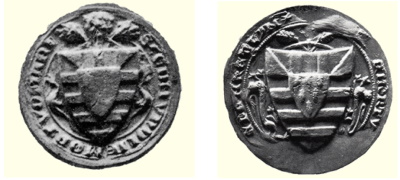
The seals of Edmund Mortimer (d1304) and Roger Mortimer of Chirk (d1326) on the Barons’ letter to the Pope of 1301. As the younger son, Roger differenced his coat of arms by making the central escutcheon ermine rather than argent and the ermine spots are quite clear on his seal
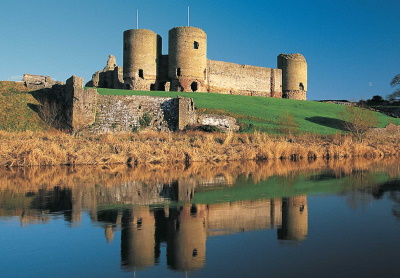
Rhuddlan Castle
One of the most important and powerful men in North Wales was the Welshman, Sir Gruffydd Llwyd. A strong supporter of the English he had been appointed, at various times, as sheriff of Caernarvonshire, of Anglesey and of Merionethshire. He acted as the king’s commissioner of array and had repeatedly raised troops for him to fight in Flanders and Scotland. An arrogant and egotistical man, Roger of Chirk saw Gruffydd as something of a competitor. Recognising his popularity and influence in the region, Roger had him imprisoned in Rhuddlan castle on two occasions. Sir Gruffydd’s revenge must have been very sweet. In January 1322, at the request of Edward II, he marched at the head of a force of Welshmen to join the king’s army, capturing Chirk castle on the way. Completely outnumbered, Roger of Chirk and his nephew surrendered. They were spared execution but imprisoned in the Tower of London. Though his nephew escaped, Roger of Chirk ended his days there dying in 1326.
Roger of Chirk ‘s marriage to Lucy le Wafre brought him estates in Wales and England, including Tedstone Wafre in east Herefordshire. After his death, however, most of his lands were taken by his acquisitive nephew, whose star was now in the ascendant. Roger of Chirk’s son, another Roger, just retained those estates that came through his mother. He was never called to parliament and the barony of Mortimer of Chirk ceased to exist.
The last surviving descendent in the direct male line from Roger of Chirk was Sir Hugh Mortimer of Martley & Tedstone Wafre who died fighting for Richard, Duke of York at the battle of Wakefield in 1460.